HI6028 Taxation: Partnership Income, Deductions & Fringe Benefits
VerifiedAdded on 2023/04/25
|9
|2117
|85
Homework Assignment
AI Summary
This assignment provides a detailed analysis of Australian taxation, focusing on partnership firms and fringe benefit tax (FBT). It includes a comprehensive computation of net income for a partnership, considering various income sources, allowable deductions, and depreciation methods as per the Income Tax Assessment Act 1997. The assignment also delves into the provisions of FBT, explaining its significance and calculation, including taxable values and gross-up rates. Specific scenarios, such as school fee payments and concessional accommodation, are analyzed to determine FBT liabilities. The document uses relevant sections of the ITAA and tax rulings to support its analysis, offering a practical understanding of Australian tax law. Desklib provides this and many other solved assignments for students.
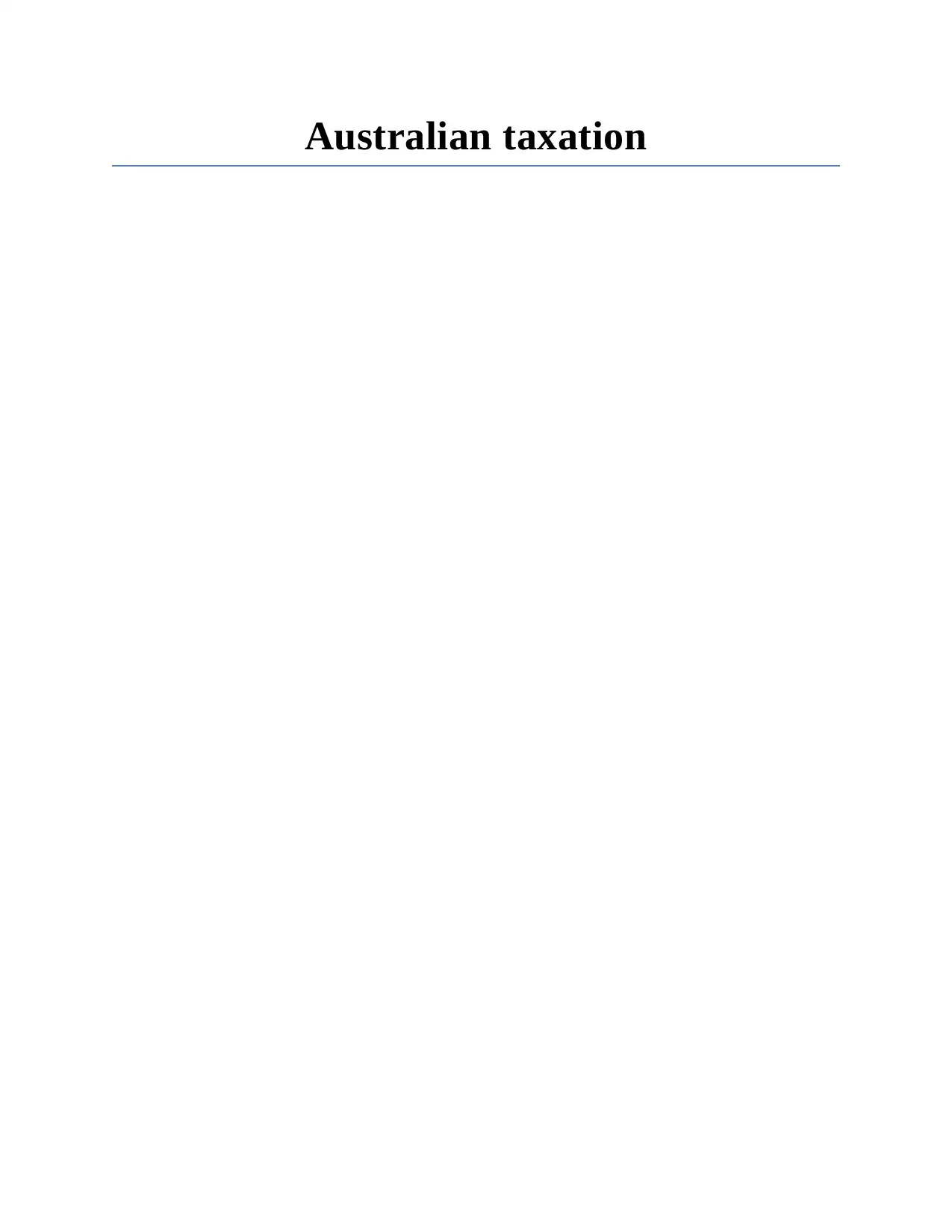
Australian taxation
Paraphrase This Document
Need a fresh take? Get an instant paraphrase of this document with our AI Paraphraser
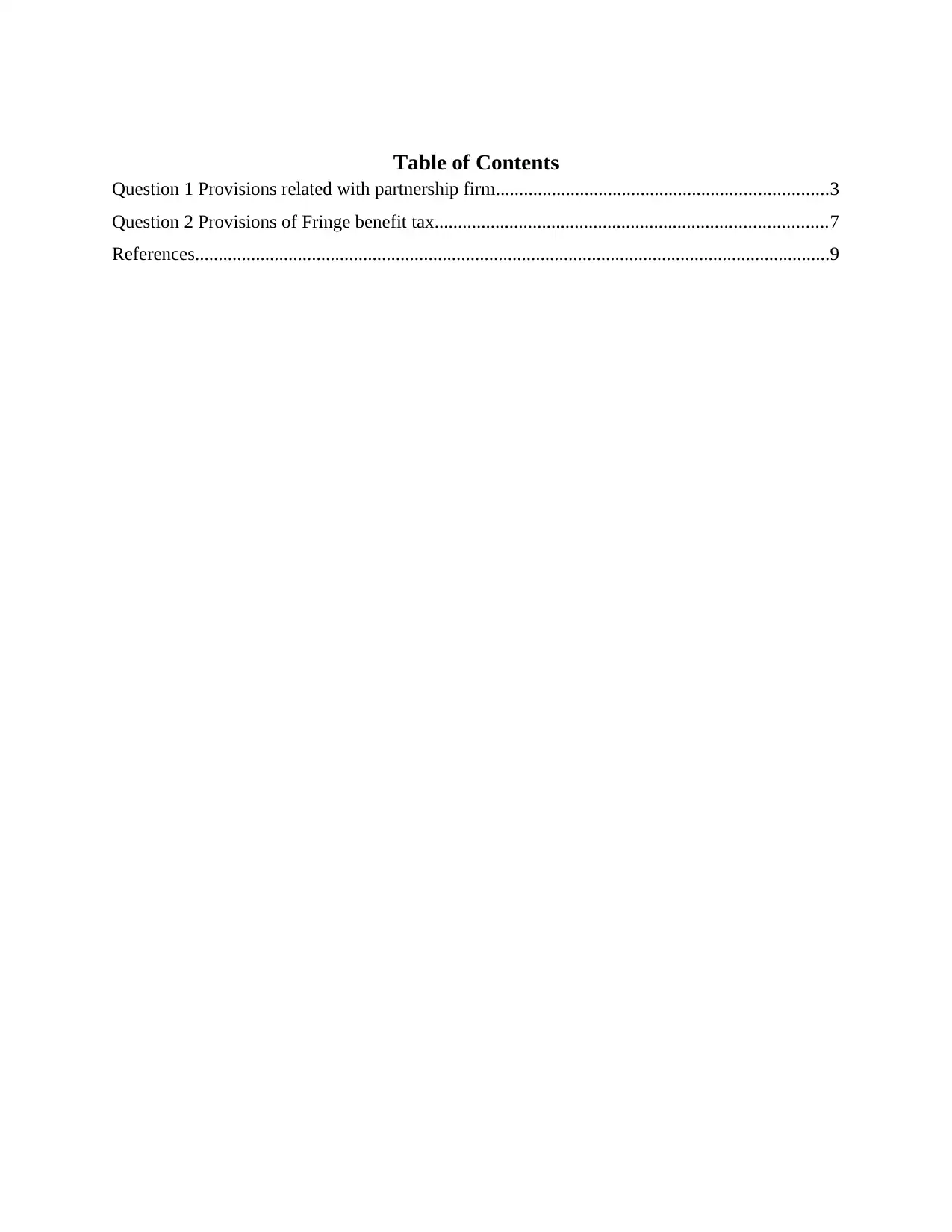
Table of Contents
Question 1 Provisions related with partnership firm.......................................................................3
Question 2 Provisions of Fringe benefit tax....................................................................................7
References........................................................................................................................................9
Question 1 Provisions related with partnership firm.......................................................................3
Question 2 Provisions of Fringe benefit tax....................................................................................7
References........................................................................................................................................9
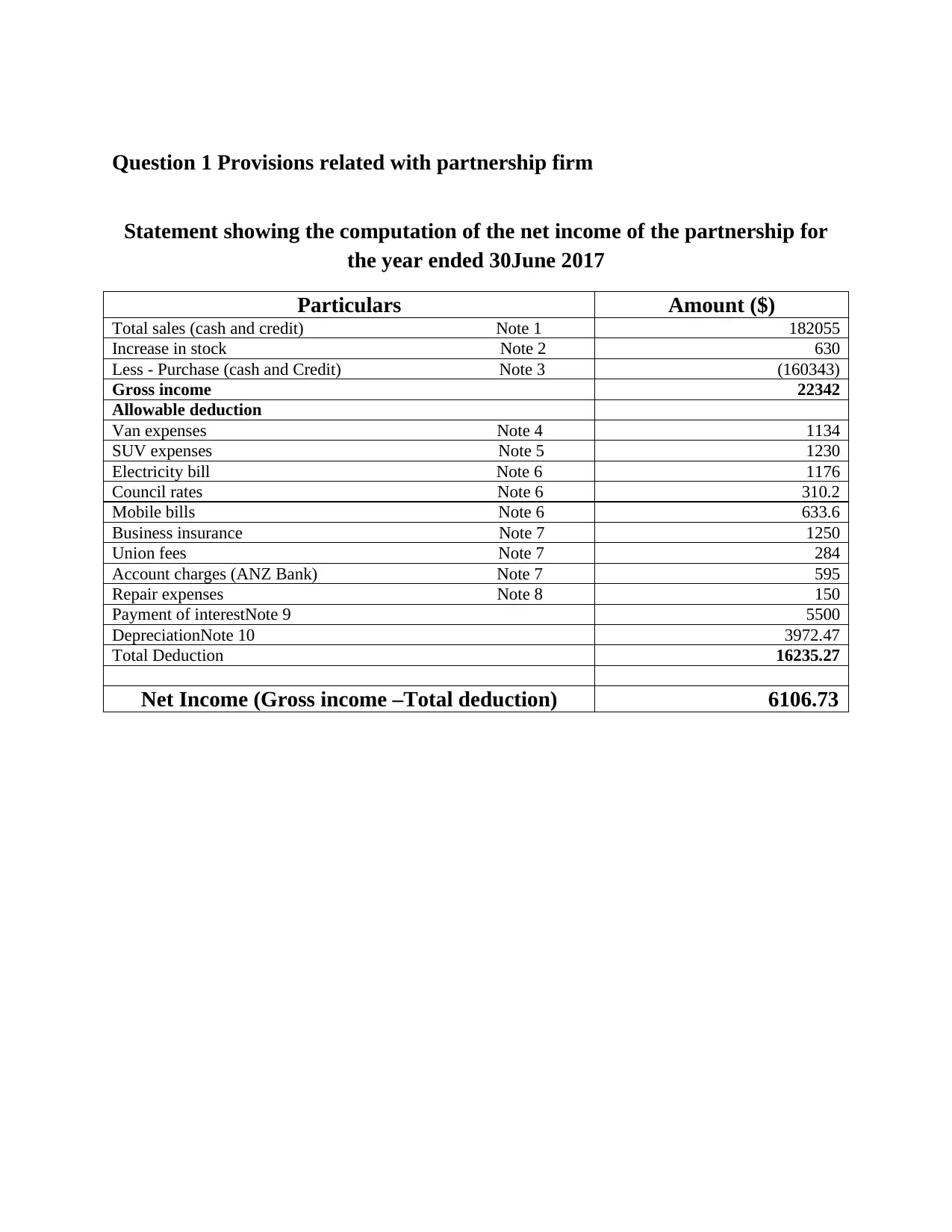
Question 1 Provisions related with partnership firm
Statement showing the computation of the net income of the partnership for
the year ended 30June 2017
Particulars Amount ($)
Total sales (cash and credit) Note 1 182055
Increase in stock Note 2 630
Less - Purchase (cash and Credit) Note 3 (160343)
Gross income 22342
Allowable deduction
Van expenses Note 4 1134
SUV expenses Note 5 1230
Electricity bill Note 6 1176
Council rates Note 6 310.2
Mobile bills Note 6 633.6
Business insurance Note 7 1250
Union fees Note 7 284
Account charges (ANZ Bank) Note 7 595
Repair expenses Note 8 150
Payment of interestNote 9 5500
DepreciationNote 10 3972.47
Total Deduction 16235.27
Net Income (Gross income –Total deduction) 6106.73
Statement showing the computation of the net income of the partnership for
the year ended 30June 2017
Particulars Amount ($)
Total sales (cash and credit) Note 1 182055
Increase in stock Note 2 630
Less - Purchase (cash and Credit) Note 3 (160343)
Gross income 22342
Allowable deduction
Van expenses Note 4 1134
SUV expenses Note 5 1230
Electricity bill Note 6 1176
Council rates Note 6 310.2
Mobile bills Note 6 633.6
Business insurance Note 7 1250
Union fees Note 7 284
Account charges (ANZ Bank) Note 7 595
Repair expenses Note 8 150
Payment of interestNote 9 5500
DepreciationNote 10 3972.47
Total Deduction 16235.27
Net Income (Gross income –Total deduction) 6106.73
⊘ This is a preview!⊘
Do you want full access?
Subscribe today to unlock all pages.

Trusted by 1+ million students worldwide
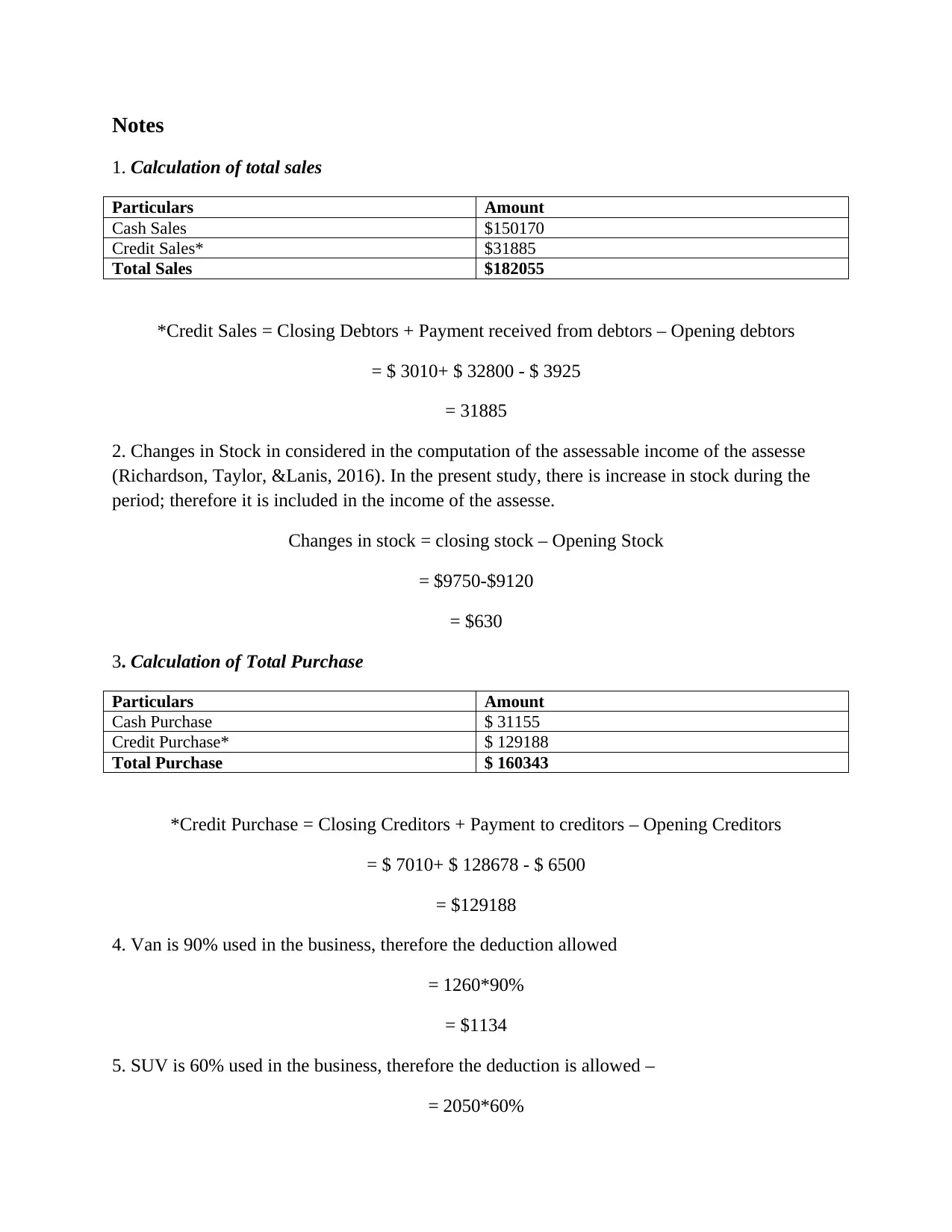
Notes
1. Calculation of total sales
Particulars Amount
Cash Sales $150170
Credit Sales* $31885
Total Sales $182055
*Credit Sales = Closing Debtors + Payment received from debtors – Opening debtors
= $ 3010+ $ 32800 - $ 3925
= 31885
2. Changes in Stock in considered in the computation of the assessable income of the assesse
(Richardson, Taylor, &Lanis, 2016). In the present study, there is increase in stock during the
period; therefore it is included in the income of the assesse.
Changes in stock = closing stock – Opening Stock
= $9750-$9120
= $630
3. Calculation of Total Purchase
Particulars Amount
Cash Purchase $ 31155
Credit Purchase* $ 129188
Total Purchase $ 160343
*Credit Purchase = Closing Creditors + Payment to creditors – Opening Creditors
= $ 7010+ $ 128678 - $ 6500
= $129188
4. Van is 90% used in the business, therefore the deduction allowed
= 1260*90%
= $1134
5. SUV is 60% used in the business, therefore the deduction is allowed –
= 2050*60%
1. Calculation of total sales
Particulars Amount
Cash Sales $150170
Credit Sales* $31885
Total Sales $182055
*Credit Sales = Closing Debtors + Payment received from debtors – Opening debtors
= $ 3010+ $ 32800 - $ 3925
= 31885
2. Changes in Stock in considered in the computation of the assessable income of the assesse
(Richardson, Taylor, &Lanis, 2016). In the present study, there is increase in stock during the
period; therefore it is included in the income of the assesse.
Changes in stock = closing stock – Opening Stock
= $9750-$9120
= $630
3. Calculation of Total Purchase
Particulars Amount
Cash Purchase $ 31155
Credit Purchase* $ 129188
Total Purchase $ 160343
*Credit Purchase = Closing Creditors + Payment to creditors – Opening Creditors
= $ 7010+ $ 128678 - $ 6500
= $129188
4. Van is 90% used in the business, therefore the deduction allowed
= 1260*90%
= $1134
5. SUV is 60% used in the business, therefore the deduction is allowed –
= 2050*60%
Paraphrase This Document
Need a fresh take? Get an instant paraphrase of this document with our AI Paraphraser
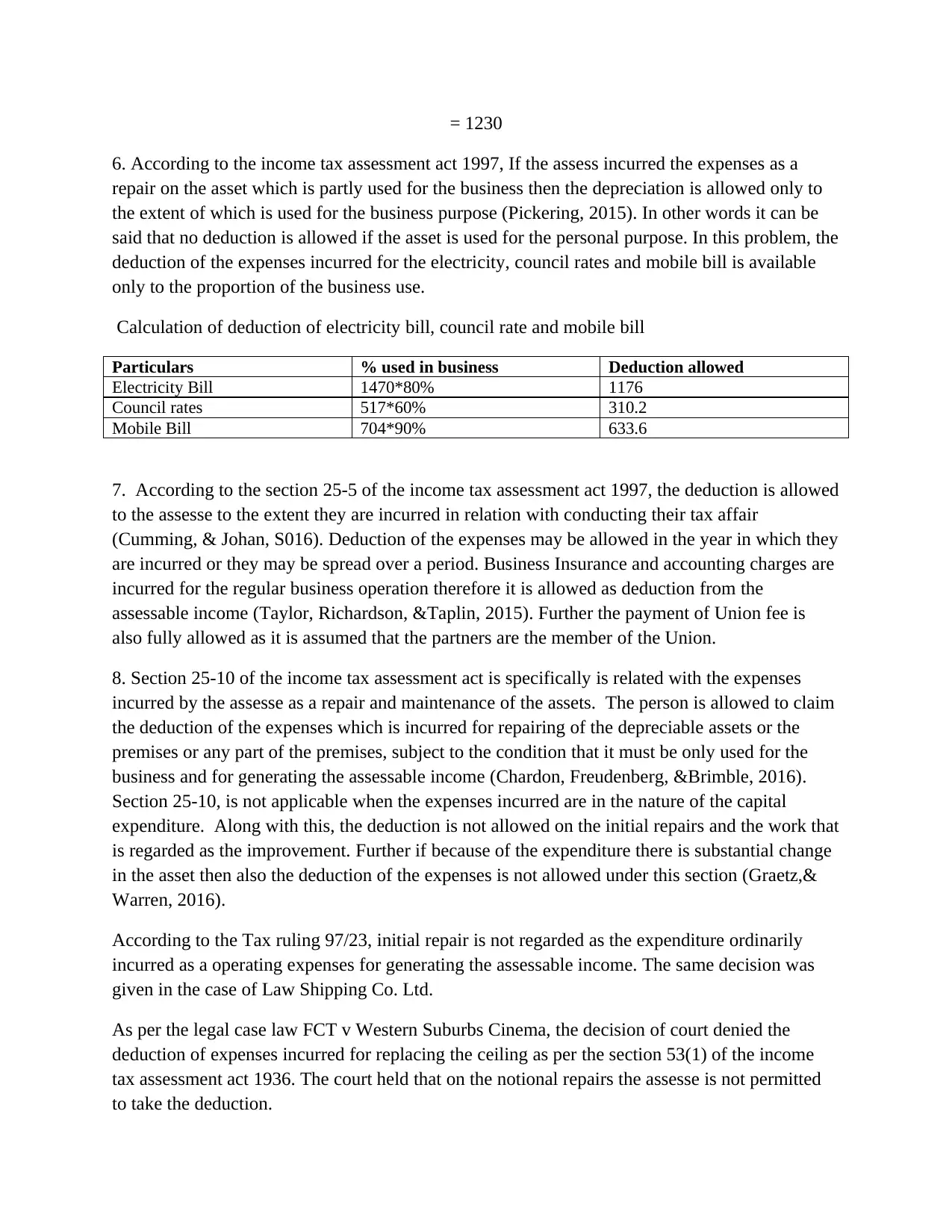
= 1230
6. According to the income tax assessment act 1997, If the assess incurred the expenses as a
repair on the asset which is partly used for the business then the depreciation is allowed only to
the extent of which is used for the business purpose (Pickering, 2015). In other words it can be
said that no deduction is allowed if the asset is used for the personal purpose. In this problem, the
deduction of the expenses incurred for the electricity, council rates and mobile bill is available
only to the proportion of the business use.
Calculation of deduction of electricity bill, council rate and mobile bill
Particulars % used in business Deduction allowed
Electricity Bill 1470*80% 1176
Council rates 517*60% 310.2
Mobile Bill 704*90% 633.6
7. According to the section 25-5 of the income tax assessment act 1997, the deduction is allowed
to the assesse to the extent they are incurred in relation with conducting their tax affair
(Cumming, & Johan, S016). Deduction of the expenses may be allowed in the year in which they
are incurred or they may be spread over a period. Business Insurance and accounting charges are
incurred for the regular business operation therefore it is allowed as deduction from the
assessable income (Taylor, Richardson, &Taplin, 2015). Further the payment of Union fee is
also fully allowed as it is assumed that the partners are the member of the Union.
8. Section 25-10 of the income tax assessment act is specifically is related with the expenses
incurred by the assesse as a repair and maintenance of the assets. The person is allowed to claim
the deduction of the expenses which is incurred for repairing of the depreciable assets or the
premises or any part of the premises, subject to the condition that it must be only used for the
business and for generating the assessable income (Chardon, Freudenberg, &Brimble, 2016).
Section 25-10, is not applicable when the expenses incurred are in the nature of the capital
expenditure. Along with this, the deduction is not allowed on the initial repairs and the work that
is regarded as the improvement. Further if because of the expenditure there is substantial change
in the asset then also the deduction of the expenses is not allowed under this section (Graetz,&
Warren, 2016).
According to the Tax ruling 97/23, initial repair is not regarded as the expenditure ordinarily
incurred as a operating expenses for generating the assessable income. The same decision was
given in the case of Law Shipping Co. Ltd.
As per the legal case law FCT v Western Suburbs Cinema, the decision of court denied the
deduction of expenses incurred for replacing the ceiling as per the section 53(1) of the income
tax assessment act 1936. The court held that on the notional repairs the assesse is not permitted
to take the deduction.
6. According to the income tax assessment act 1997, If the assess incurred the expenses as a
repair on the asset which is partly used for the business then the depreciation is allowed only to
the extent of which is used for the business purpose (Pickering, 2015). In other words it can be
said that no deduction is allowed if the asset is used for the personal purpose. In this problem, the
deduction of the expenses incurred for the electricity, council rates and mobile bill is available
only to the proportion of the business use.
Calculation of deduction of electricity bill, council rate and mobile bill
Particulars % used in business Deduction allowed
Electricity Bill 1470*80% 1176
Council rates 517*60% 310.2
Mobile Bill 704*90% 633.6
7. According to the section 25-5 of the income tax assessment act 1997, the deduction is allowed
to the assesse to the extent they are incurred in relation with conducting their tax affair
(Cumming, & Johan, S016). Deduction of the expenses may be allowed in the year in which they
are incurred or they may be spread over a period. Business Insurance and accounting charges are
incurred for the regular business operation therefore it is allowed as deduction from the
assessable income (Taylor, Richardson, &Taplin, 2015). Further the payment of Union fee is
also fully allowed as it is assumed that the partners are the member of the Union.
8. Section 25-10 of the income tax assessment act is specifically is related with the expenses
incurred by the assesse as a repair and maintenance of the assets. The person is allowed to claim
the deduction of the expenses which is incurred for repairing of the depreciable assets or the
premises or any part of the premises, subject to the condition that it must be only used for the
business and for generating the assessable income (Chardon, Freudenberg, &Brimble, 2016).
Section 25-10, is not applicable when the expenses incurred are in the nature of the capital
expenditure. Along with this, the deduction is not allowed on the initial repairs and the work that
is regarded as the improvement. Further if because of the expenditure there is substantial change
in the asset then also the deduction of the expenses is not allowed under this section (Graetz,&
Warren, 2016).
According to the Tax ruling 97/23, initial repair is not regarded as the expenditure ordinarily
incurred as a operating expenses for generating the assessable income. The same decision was
given in the case of Law Shipping Co. Ltd.
As per the legal case law FCT v Western Suburbs Cinema, the decision of court denied the
deduction of expenses incurred for replacing the ceiling as per the section 53(1) of the income
tax assessment act 1936. The court held that on the notional repairs the assesse is not permitted
to take the deduction.

By considering the present study, repair and maintenances expenses related with the air condition
installation is considered as the capital expenditure therefore the deduction is not allowed.
Further the expenses incurred for shop painting fulfills the criteria of repair and maintenance the
same is considered as the revenue expenditure and allowed as deduction. Moreover expenditure
on refrigerator motor replacement is considered as the capital expenditure because it results in
the substantial improvement in the asset.
9. Deduction is allowed on the payment of interest on the borrowings only if the borrowings are
used in the business (McGregor-Lowndes, &Crittall, 2017). It is assumed that the firm used the
borrowing for conducting its business activities therefore the payment of interest is allowed as
deduction.
Interest = Total Payment – Principle Amount
= $ 8500 - $ 3000
= $ 5500
10. According to the ITAA 97, Division 40, depreciation means decline in the value of the
depreciation asset. The assesse is permitted to claim the deduction of the depreciation expenses.
There are two methods by which the depreciation can be computed, prime cost method and the
diminishing method.
In the given study, the depreciation is computed by diminishing method.
Assets purchased before to 10 may 2006
= Base Value * Days held/ 365 * 150%/ effective life of the asset.
Assets purchased after 10 may 2006
= Base Value * Days held/ 365 * 200%/ effective life of the asset.
In the present problem, all assets are purchased before 2006 except the new refrigerator. The
effective life of the asset is prescribed by the ATO and same is considered for the computation of
the depreciation.
The effective life of the freezer and refrigerator asset is 10 year, shop fitting structure is 20 years,
Kitchen electrical appliances is 2 years and on the Car is 20 years. It has been assumed that
kitchen electric appliances are consisting of electric appliances such as jugs and kettles and
further shop fitting structure is the general fittings.
Statement of depreciation
installation is considered as the capital expenditure therefore the deduction is not allowed.
Further the expenses incurred for shop painting fulfills the criteria of repair and maintenance the
same is considered as the revenue expenditure and allowed as deduction. Moreover expenditure
on refrigerator motor replacement is considered as the capital expenditure because it results in
the substantial improvement in the asset.
9. Deduction is allowed on the payment of interest on the borrowings only if the borrowings are
used in the business (McGregor-Lowndes, &Crittall, 2017). It is assumed that the firm used the
borrowing for conducting its business activities therefore the payment of interest is allowed as
deduction.
Interest = Total Payment – Principle Amount
= $ 8500 - $ 3000
= $ 5500
10. According to the ITAA 97, Division 40, depreciation means decline in the value of the
depreciation asset. The assesse is permitted to claim the deduction of the depreciation expenses.
There are two methods by which the depreciation can be computed, prime cost method and the
diminishing method.
In the given study, the depreciation is computed by diminishing method.
Assets purchased before to 10 may 2006
= Base Value * Days held/ 365 * 150%/ effective life of the asset.
Assets purchased after 10 may 2006
= Base Value * Days held/ 365 * 200%/ effective life of the asset.
In the present problem, all assets are purchased before 2006 except the new refrigerator. The
effective life of the asset is prescribed by the ATO and same is considered for the computation of
the depreciation.
The effective life of the freezer and refrigerator asset is 10 year, shop fitting structure is 20 years,
Kitchen electrical appliances is 2 years and on the Car is 20 years. It has been assumed that
kitchen electric appliances are consisting of electric appliances such as jugs and kettles and
further shop fitting structure is the general fittings.
Statement of depreciation
⊘ This is a preview!⊘
Do you want full access?
Subscribe today to unlock all pages.

Trusted by 1+ million students worldwide
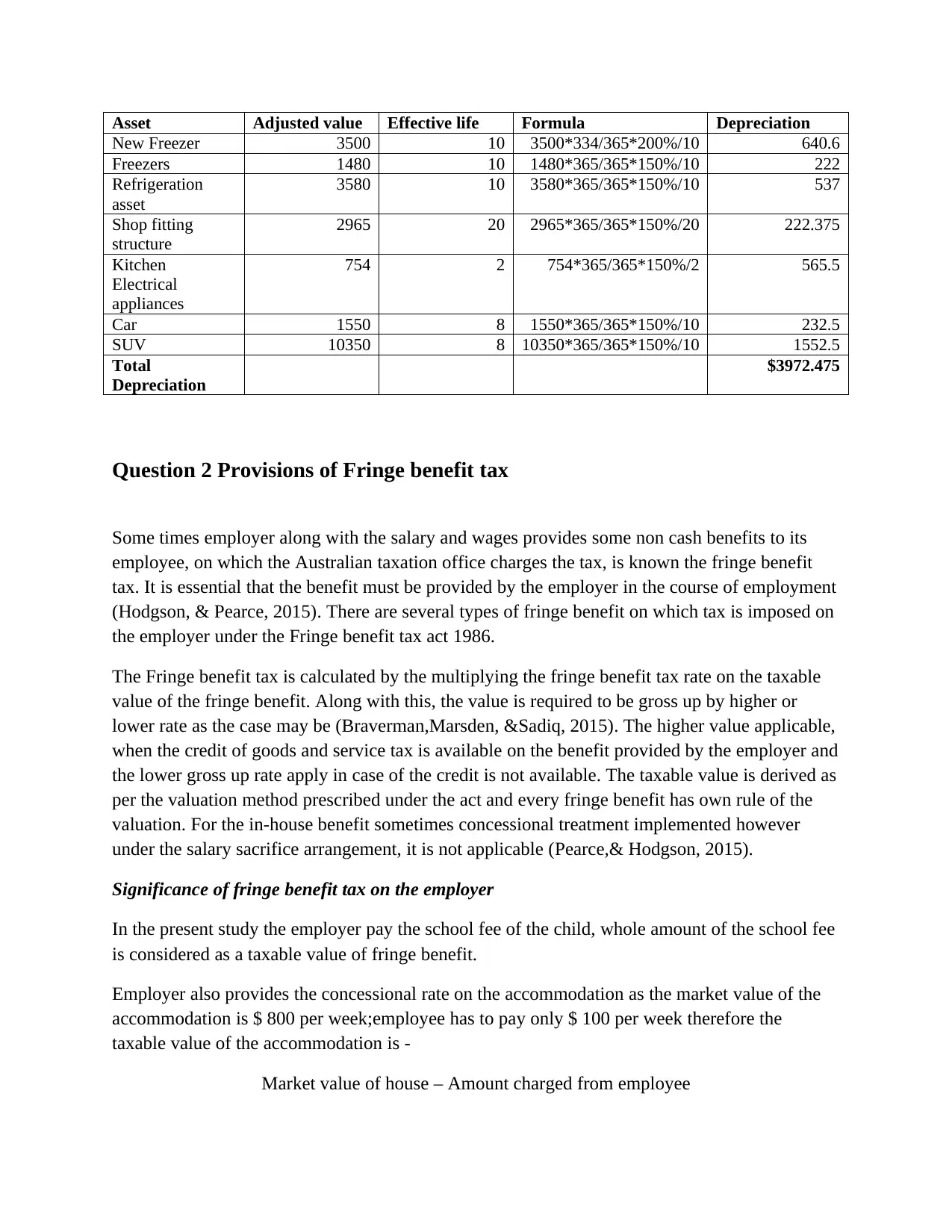
Asset Adjusted value Effective life Formula Depreciation
New Freezer 3500 10 3500*334/365*200%/10 640.6
Freezers 1480 10 1480*365/365*150%/10 222
Refrigeration
asset
3580 10 3580*365/365*150%/10 537
Shop fitting
structure
2965 20 2965*365/365*150%/20 222.375
Kitchen
Electrical
appliances
754 2 754*365/365*150%/2 565.5
Car 1550 8 1550*365/365*150%/10 232.5
SUV 10350 8 10350*365/365*150%/10 1552.5
Total
Depreciation
$3972.475
Question 2 Provisions of Fringe benefit tax
Some times employer along with the salary and wages provides some non cash benefits to its
employee, on which the Australian taxation office charges the tax, is known the fringe benefit
tax. It is essential that the benefit must be provided by the employer in the course of employment
(Hodgson, & Pearce, 2015). There are several types of fringe benefit on which tax is imposed on
the employer under the Fringe benefit tax act 1986.
The Fringe benefit tax is calculated by the multiplying the fringe benefit tax rate on the taxable
value of the fringe benefit. Along with this, the value is required to be gross up by higher or
lower rate as the case may be (Braverman,Marsden, &Sadiq, 2015). The higher value applicable,
when the credit of goods and service tax is available on the benefit provided by the employer and
the lower gross up rate apply in case of the credit is not available. The taxable value is derived as
per the valuation method prescribed under the act and every fringe benefit has own rule of the
valuation. For the in-house benefit sometimes concessional treatment implemented however
under the salary sacrifice arrangement, it is not applicable (Pearce,& Hodgson, 2015).
Significance of fringe benefit tax on the employer
In the present study the employer pay the school fee of the child, whole amount of the school fee
is considered as a taxable value of fringe benefit.
Employer also provides the concessional rate on the accommodation as the market value of the
accommodation is $ 800 per week;employee has to pay only $ 100 per week therefore the
taxable value of the accommodation is -
Market value of house – Amount charged from employee
New Freezer 3500 10 3500*334/365*200%/10 640.6
Freezers 1480 10 1480*365/365*150%/10 222
Refrigeration
asset
3580 10 3580*365/365*150%/10 537
Shop fitting
structure
2965 20 2965*365/365*150%/20 222.375
Kitchen
Electrical
appliances
754 2 754*365/365*150%/2 565.5
Car 1550 8 1550*365/365*150%/10 232.5
SUV 10350 8 10350*365/365*150%/10 1552.5
Total
Depreciation
$3972.475
Question 2 Provisions of Fringe benefit tax
Some times employer along with the salary and wages provides some non cash benefits to its
employee, on which the Australian taxation office charges the tax, is known the fringe benefit
tax. It is essential that the benefit must be provided by the employer in the course of employment
(Hodgson, & Pearce, 2015). There are several types of fringe benefit on which tax is imposed on
the employer under the Fringe benefit tax act 1986.
The Fringe benefit tax is calculated by the multiplying the fringe benefit tax rate on the taxable
value of the fringe benefit. Along with this, the value is required to be gross up by higher or
lower rate as the case may be (Braverman,Marsden, &Sadiq, 2015). The higher value applicable,
when the credit of goods and service tax is available on the benefit provided by the employer and
the lower gross up rate apply in case of the credit is not available. The taxable value is derived as
per the valuation method prescribed under the act and every fringe benefit has own rule of the
valuation. For the in-house benefit sometimes concessional treatment implemented however
under the salary sacrifice arrangement, it is not applicable (Pearce,& Hodgson, 2015).
Significance of fringe benefit tax on the employer
In the present study the employer pay the school fee of the child, whole amount of the school fee
is considered as a taxable value of fringe benefit.
Employer also provides the concessional rate on the accommodation as the market value of the
accommodation is $ 800 per week;employee has to pay only $ 100 per week therefore the
taxable value of the accommodation is -
Market value of house – Amount charged from employee
Paraphrase This Document
Need a fresh take? Get an instant paraphrase of this document with our AI Paraphraser

= 800-100
= $700 per Week
For 12 month = 700*52 week = $36400
Total taxable value of fringe benefit
$15000+$36400
= $51400
Fringe benefit tax liability
= $51400*49%*1.9608
= $49384.70
*31March 2017, rate of FBT is considered.
*Credit of GST is not apply therefore the lower gross up rate is considered.
= $700 per Week
For 12 month = 700*52 week = $36400
Total taxable value of fringe benefit
$15000+$36400
= $51400
Fringe benefit tax liability
= $51400*49%*1.9608
= $49384.70
*31March 2017, rate of FBT is considered.
*Credit of GST is not apply therefore the lower gross up rate is considered.
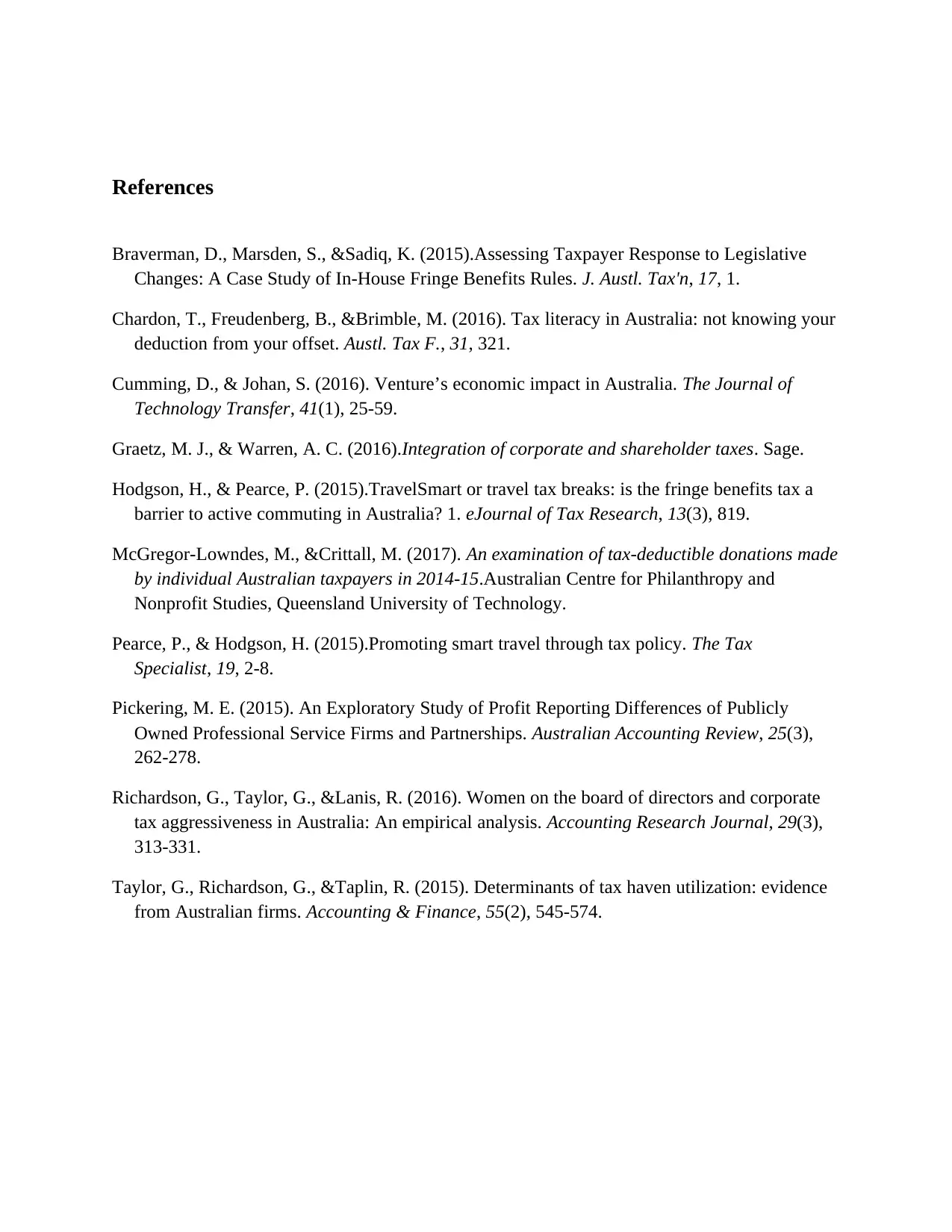
References
Braverman, D., Marsden, S., &Sadiq, K. (2015).Assessing Taxpayer Response to Legislative
Changes: A Case Study of In-House Fringe Benefits Rules. J. Austl. Tax'n, 17, 1.
Chardon, T., Freudenberg, B., &Brimble, M. (2016). Tax literacy in Australia: not knowing your
deduction from your offset. Austl. Tax F., 31, 321.
Cumming, D., & Johan, S. (2016). Venture’s economic impact in Australia. The Journal of
Technology Transfer, 41(1), 25-59.
Graetz, M. J., & Warren, A. C. (2016).Integration of corporate and shareholder taxes. Sage.
Hodgson, H., & Pearce, P. (2015).TravelSmart or travel tax breaks: is the fringe benefits tax a
barrier to active commuting in Australia? 1. eJournal of Tax Research, 13(3), 819.
McGregor-Lowndes, M., &Crittall, M. (2017). An examination of tax-deductible donations made
by individual Australian taxpayers in 2014-15.Australian Centre for Philanthropy and
Nonprofit Studies, Queensland University of Technology.
Pearce, P., & Hodgson, H. (2015).Promoting smart travel through tax policy. The Tax
Specialist, 19, 2-8.
Pickering, M. E. (2015). An Exploratory Study of Profit Reporting Differences of Publicly
Owned Professional Service Firms and Partnerships. Australian Accounting Review, 25(3),
262-278.
Richardson, G., Taylor, G., &Lanis, R. (2016). Women on the board of directors and corporate
tax aggressiveness in Australia: An empirical analysis. Accounting Research Journal, 29(3),
313-331.
Taylor, G., Richardson, G., &Taplin, R. (2015). Determinants of tax haven utilization: evidence
from Australian firms. Accounting & Finance, 55(2), 545-574.
Braverman, D., Marsden, S., &Sadiq, K. (2015).Assessing Taxpayer Response to Legislative
Changes: A Case Study of In-House Fringe Benefits Rules. J. Austl. Tax'n, 17, 1.
Chardon, T., Freudenberg, B., &Brimble, M. (2016). Tax literacy in Australia: not knowing your
deduction from your offset. Austl. Tax F., 31, 321.
Cumming, D., & Johan, S. (2016). Venture’s economic impact in Australia. The Journal of
Technology Transfer, 41(1), 25-59.
Graetz, M. J., & Warren, A. C. (2016).Integration of corporate and shareholder taxes. Sage.
Hodgson, H., & Pearce, P. (2015).TravelSmart or travel tax breaks: is the fringe benefits tax a
barrier to active commuting in Australia? 1. eJournal of Tax Research, 13(3), 819.
McGregor-Lowndes, M., &Crittall, M. (2017). An examination of tax-deductible donations made
by individual Australian taxpayers in 2014-15.Australian Centre for Philanthropy and
Nonprofit Studies, Queensland University of Technology.
Pearce, P., & Hodgson, H. (2015).Promoting smart travel through tax policy. The Tax
Specialist, 19, 2-8.
Pickering, M. E. (2015). An Exploratory Study of Profit Reporting Differences of Publicly
Owned Professional Service Firms and Partnerships. Australian Accounting Review, 25(3),
262-278.
Richardson, G., Taylor, G., &Lanis, R. (2016). Women on the board of directors and corporate
tax aggressiveness in Australia: An empirical analysis. Accounting Research Journal, 29(3),
313-331.
Taylor, G., Richardson, G., &Taplin, R. (2015). Determinants of tax haven utilization: evidence
from Australian firms. Accounting & Finance, 55(2), 545-574.
⊘ This is a preview!⊘
Do you want full access?
Subscribe today to unlock all pages.

Trusted by 1+ million students worldwide
1 out of 9
Related Documents
Your All-in-One AI-Powered Toolkit for Academic Success.
+13062052269
info@desklib.com
Available 24*7 on WhatsApp / Email
![[object Object]](/_next/static/media/star-bottom.7253800d.svg)
Unlock your academic potential
Copyright © 2020–2025 A2Z Services. All Rights Reserved. Developed and managed by ZUCOL.





